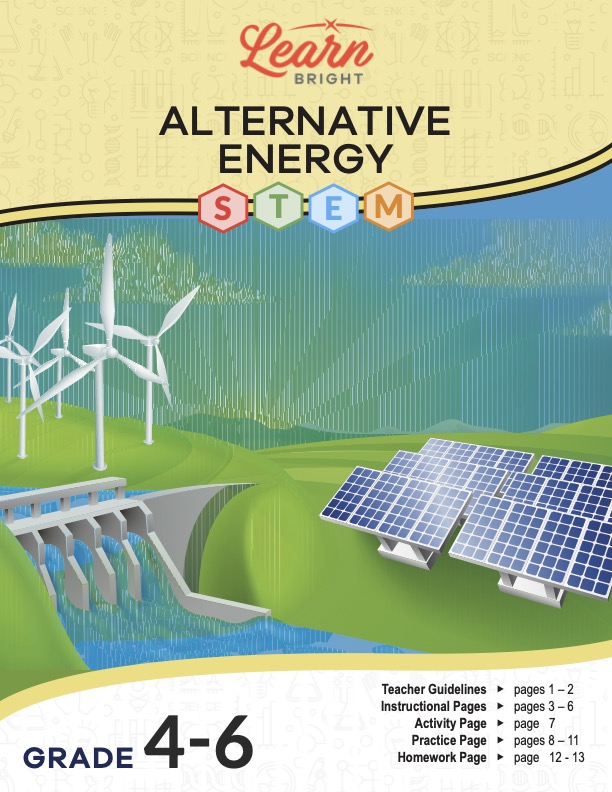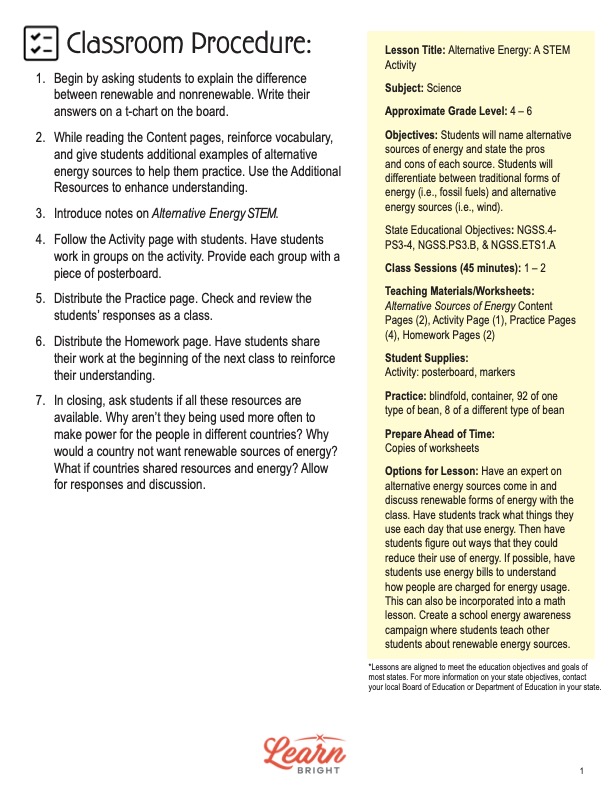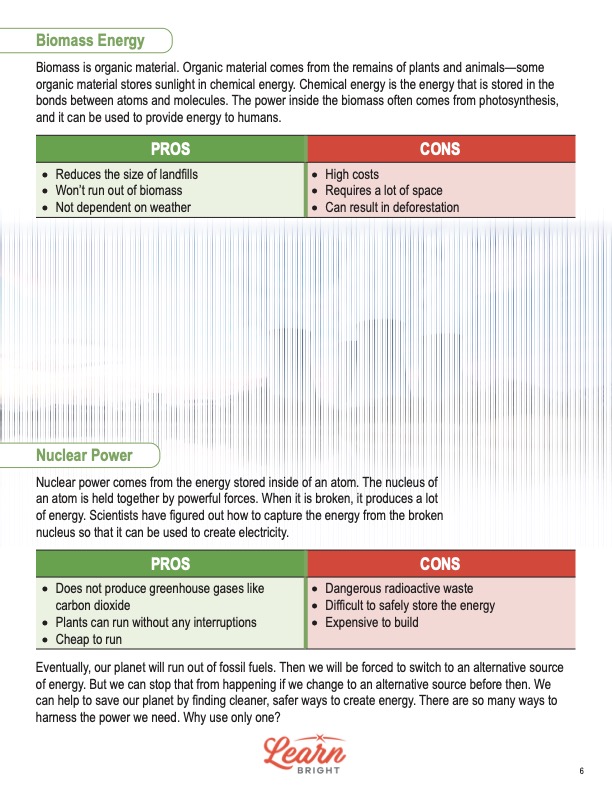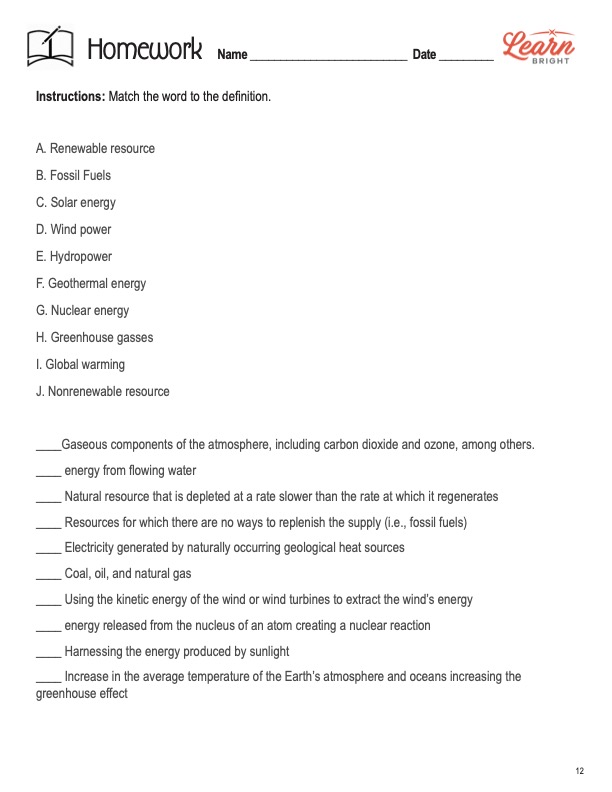Description
What our Alternative Energy STEM lesson plan includes
Lesson Objectives and Overview: Alternative Energy STEM explores the various sources of energy that we can use instead of traditional forms. Students will discover the pros and cons of each source. They will also learn how to differentiate between a traditional and an alternative energy source. This lesson is for students in 4th grade, 5th grade, and 6th grade.
Classroom Procedure
Every lesson plan provides you with a classroom procedure page that outlines a step-by-step guide to follow. You do not have to follow the guide exactly. The guide helps you organize the lesson and details when to hand out worksheets. It also lists information in the yellow box that you might find useful. You will find the lesson objectives, state standards, and number of class sessions the lesson should take to complete in this area. In addition, it describes the supplies you will need as well as what and how you need to prepare beforehand. For this lesson, you will need poster board, markers, blindfolds, containers, and 92 of one type of bean and 8 of a different type of bean for each pair of students.
Options for Lesson
In the “Options for Lesson” section of the classroom procedure page, you’ll find several suggestions for additional activities or exercises to incorporate into the lesson if you want to. One idea is to have an expert on alternative energy sources come discuss renewable forms of energy with the class and answer their questions. Another option is for students to track things they use each day that require energy; you can then have them figure out ways that they could reduce their energy use. If possible, you could have students use energy bills to understand how people are charged for their energy usage. This can also be incorporated into a math lesson. One more suggestion is to create a school energy awareness campaign during which your students will teach other students about renewable energy sources.
Teacher Notes
The teacher notes page provides an extra paragraph of information to help guide the lesson. You can use the blank lines to write down any other ideas or thoughts you have about the topic as you prepare.
ALTERNATIVE ENERGY STEM LESSON PLAN CONTENT PAGES
Why We Need Alternative Energy Sources
The Alternative Energy STEM lesson plan contains a total of four content pages. First, students will learn why we need alternate sources of energy in the first place. We use energy to heat our homes, power our cars, and light up buildings. The traditional energy sources we use now are fossil fuels—coal, oil, and natural gas. But the problem is that there is a limit to these sources, so there are only so many on Earth before we run out.
Additionally, traditional sources of energy cause damage to the Earth by harming the natural environment. When we burn fossil fuels, they release more carbon dioxide into the atmosphere. The result is that the planet heats up. Burning fossil fuels also releases other dangerous pollutants such as carbon monoxide and nitrogen dioxide. Because of this, people have started thinking of other ways to create energy.
Energy sources that don’t run out are what we call renewable energy sources. Many people also refer to them as “green” forms of energy. There are many types. This lesson describes solar, wind, hydro, geothermal, biomass, and nuclear energy sources. It explains what the pros and cons are of using each of these six sources.
Solar and Wind Energy
Students will learn that the giant panels on the roofs of houses and other buildings are called solar panels. The purpose of these panels is to convert sunlight into energy, hence the name solar energy. A solar panel harnesses the heat and light from the sun and turns it into energy that people can use. Utility companies use photovoltaic systems to capture the heat and light to accomplish this goal.
Using solar energy has many pros. It’s affordable, creates lots of energy, and works in lots of climates. It can also produce electricity or heat and produces minimal pollution. However, there are cons as well, the biggest being that it doesn’t work at night. It also uses a lot of space, and some roofs are not built to capture sunlight. Lastly, people can’t install solar systems themselves.
Wind energy simply involves using the moving air in the atmosphere. Scientists harvest wind through windmills to create power. They collect energy through the kinetic energy of the wind itself.
When it comes to the pros of wind energy, the turbines spin only from the wind. It’s a very clean energy source that is extremely efficient and does not disrupt farmland. However, it is dangerous to some wildlife. It’s also noisy and unpredictable, and it’s expensive to build and install.
Hydro and Geothermal Energy
The next energy sources students will learn about is hydro. Hydro power converts kinetic energy from falling water into fuel. Collecting hydro energy doesn’t actually use up water. It simply uses its power to create energy. When a lot of water moves very fast, it can cause a generator to turn, producing electricity. Students will discover that hydro power is the oldest form of energy collection. Many dams were made to help humans capture the power of water.
This energy source is reliable, renewable, and clean (no pollutants). It even creates recreation by building lakes. However, it interrupts the natural flow of the water. Power plants for hydro power are expensive to build. They emit carbon dioxide and methane into the atmosphere and can lead to droughts.
Geothermal energy comes from the heat of the earth itself. We can find heat almost anywhere in the world. Geothermal energy simply involves moving heat from one place to another rather than creating new heat.
Using geothermal energy is efficient in small applications. It’s sustainable, affordable, and provides the smallest carbon footprint of any energy source. On the other hand, consumers have to be close the heat source. Large-scale geothermal power plants are dangerous to the Earth’s surface. In addition, we would still need electricity to operate heat pumps.
Biomass and Nuclear Energy
Another alternative energy source is biomass, which is organic material from the remains of plants and animals. Some of this material stores sunlight as chemical energy. Chemical energy is the energy stored in the bonds between atoms and molecules. The power inside biomass often comes from photosynthesis, and we can use this power to provide energy to humans.
Biomass as an energy source reduces the size of landfills. It doesn’t depend on the weather in any way, and we will never run out of it. But it costs a lot of use and requires a lot of space. It can also result in deforestation.
Finally, students will learn about nuclear power, which comes from the energy stored within an atom. The nucleus of an atom stays together because of powerful forces. When it breaks, it produces a lot of energy. Scientists have figured out how to capture the energy from a broken nucleus and use it to create electricity.
Nuclear energy does not produce greenhouse gases like carbon dioxide. Nuclear power plants can run without any interruptions, and they’re cheap to run as well. However, they do produce dangerous radioactive waste. It’s difficult to safely store the energy, and the plants are expensive to build.
Our planet will eventually run out of fossil fuels, so we will be forced to switch to other sources of energy. We can start using them now, however, so that we don’t run out of those non-renewable sources. Plus, we can help save the planet by finding cleaner, safer ways to create energy.
ALTERNATIVE ENERGY STEM LESSON PLAN WORKSHEETS
The Alternative Energy STEM lesson plan includes three worksheets: an activity worksheet, a practice worksheet, and a homework assignment. Each one will reinforce students’ comprehension of lesson material in different ways and help them demonstrate when they learned. Use the guidelines on the classroom procedure page to determine when to distribute each worksheet to the class.
CREATE A NEW ENERGY SOURCE ACTIVITY WORKSHEET
Students will get their creative juices flowing for this activity. They must imagine the school is running out of the energy and create a new renewable energy source to keep the lights on and the computers running. After deciding which type of alternative energy they will use, students will create a list of materials and resources they need to implement their chosen source. Then they will list three reasons they chose that type of energy source.
After preparing this information, students will also create posters. The posters must display the type of alternative energy students chose and a drawing or diagram of their energy plan. In addition, they will list the pros and cons for the school and the environment. Finally, they will explain why they believe this is the best source of energy for the school.
PREDICTION TIME PRACTICE WORKSHEET
For the practice worksheet, students will work with a partner. Each pair of students will put 100 beans (92 of one color and 8 of another) in a container. One person will put on a blindfold and represent a population who uses energy without thinking about it. Throughout the assignment, they will pull beans out of the container. Each time it is a renewable resource, they will return it to the container before drawing again.
The students will predict how long it will take before the nonrenewable energy is gone. They will take out 10 beans at a time and mark in the table how many renewable energy sources remain. When all the beans are gone, they will write how many years it took before the nonrenewable energy was gone. Then they will return all the beans to the container and start over, this time taking five more beans out each year. At the end, they will respond to the two prompts at the bottom of the second practice page.
ALTERNATIVE ENERGY STEM HOMEWORK ASSIGNMENT
The homework assignment requires students to match definitions and terms. They will review 10 definitions and match them to the correct term from the word bank. You can choose whether or not you allow students to use the content pages for reference.
Worksheet Answer Keys
The lesson plan document provides answer keys for the practice and homework worksheets. Given the nature of the practice worksheet, the answers will vary depending on each experiment. For the homework assignment, however, students’ responses should match exactly. If you choose to administer the lesson pages to your students via PDF, you will need to save a new file that omits these pages. Otherwise, you can simply print out the applicable pages and keep these as reference for yourself when grading assignments.










